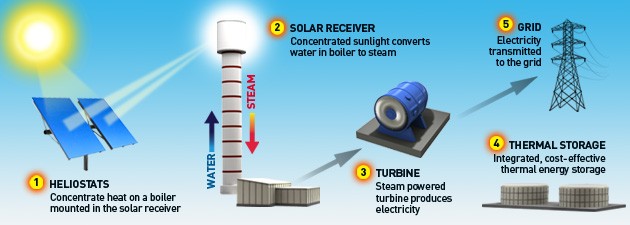Ivanpah – Is it Already Obsolete?
In our last article on Ivanpah, we discussed how Ivanpah operates in a different manner than what most people think of when we talk about solar energy. We learned that we typically think of photovoltaic (PV) solar energy when we think of solar, not thermal solar energy; and we learned that the difference is basically that unlike PV which directly converts sunlight to energy, Ivanpah uses mirrors to direct sunlight to heat water to create steam to turn turbines, which create energy.

We followed by asking, well isn’t that just a little complicated? Considering PV is much more direct?
Well, we can’t offer you an answer; but we can offer you some information. Let’s start at trying to compare it to something similar. Ivanpah lies on roughly 4,000 acres, and is capable of creating 392 Megawatts of power. The overall cost of the project was roughly $2.2B.
Just up the street in Antelope Valley, California, Warren Buffett (and friends) has been involved in a 3,230 acre project of nearly the same budget. This project will use PV solar, rather than thermal solar. The project is expected to produce 579 Megawatts. Watt? I mean, what?
The PV project is going to use up 80% of the land Ivanpah does, and will produce almost 1.5 times the power. It is seemingly an easy answer. Yes, Ivanpah is already obsolete. But, there may be other factors that come in to play.
For instance, according to BrightSource, Ivanpah employed about 1,000 workers at the height of construction, and is employing 86 permanent workers. The numbers on the PV project are not known, but will likely require much less of a work force to build, maintain and operate. Is that enough to offset the disadvantages? Only time will tell.
As far as this author is concerned, I don’t know the answer, but I think PV will ultimately turn out to be the better solutions for our needs. None-the-less, Ivanpah should be praised for the emissions it is reducing and the homes it is supplying power to. Ivanpah is still far less obsolete than our oil, coal or gas plants. Ivanpah is much safer than nuclear energy. The bottom line is, I really hope that these types of debates are the future of our energy debates, rather than debating whether or not we want to continue killing the earth.